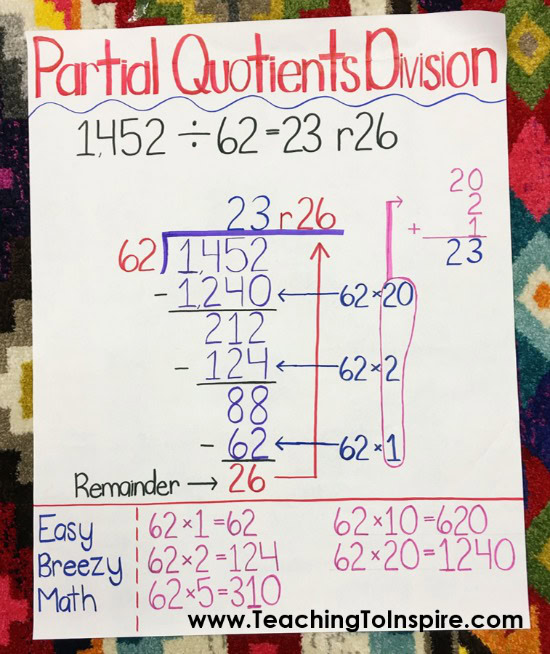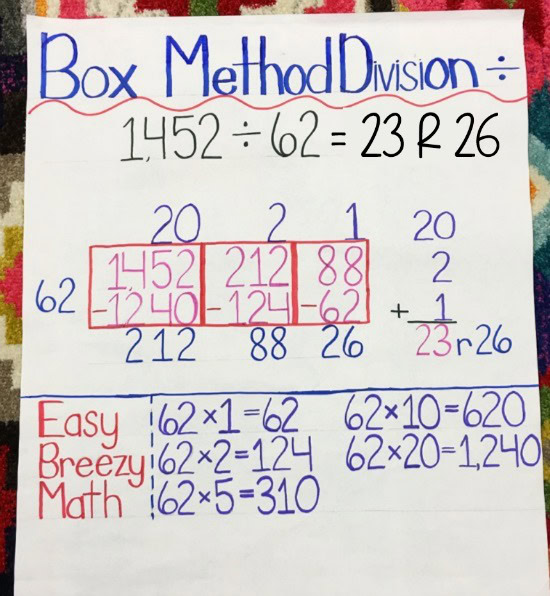Do you dread teaching division each year? I used to be in that camp. My students struggled big time with division because they lacked number sense and conceptual understanding. However, and thankfully, I learned that it doesn’t have to be like that. I can use division strategies that are not only developmentally appropriate but that also make sense for my students.
In fact, as soon as I abandoned the standard algorithm as my go-to division strategy, my students began mastering division left and right. Did some still struggle? Yes. Unfortunately, none of the division strategies or tips I share are going to be a magic pill, but they will make division accessible and conceptual for your students.
Partial Quotients with Easy Breezy Math
Partial quotients was a game-changer for my students. Partial quotients is a division strategy that uses chunking to repeatedly subtract groups of the divisor in a more efficient way.
But, I had to add in a scaffold for my students. We call this scaffold our “Easy Breezy Math.” Basically, we take the multiplication that we do know and write them off to the side. We pull from those problems to help us solve the problem. We do this because my students really lack division number sense at the beginning of the year. This also helps them see the connections between multiplication and division.
As the year goes on, they will move beyond their Easy Breezy Math as they develop their number sense and start to see patterns.
Tip: Remind them to stack the factors vertically on their Easy Breezy Math. Sometimes I give my students whiteboards specifically for these to make it a bit more engaging.
For more detailed information about this division method and to get freebies to help, click here.
If this strategy is new for you and you need to see it in action, then check out this video.
Box Model or Box Method with Partial Quotients
Box Model Division one was new to me a year ago and works best when the students are familiar with using this type of organizer when multiplying with partial products. This type of division strategy is similar to partial quotients but is organized in a different way.
If this is completely new to you, then check out the video of a teacher and her class going through the steps. This method is best to “see in action” rather than to read about it.
That video is longer, but it is great for helping teachers understand the division strategy and hearing some language to help the students understand it. Note: The What I Know part of the work is the same as what I call “Easy Breezy Math.”
I highly recommend introducing this strategy (and really any strategy, but definitely this one) in the context of a word problem to help the students conceptualize the strategy and really understand what is going on. It is helpful to name the dividend and the divisor in relation to a context.
Tips for Teaching Division (With Any Division Strategy)
1.) Introduce new strategies with an engaging context or word problem. As you walk through the steps of the strategy, walk through what would be happening in the problem.
2.) If these strategies are completely new, then spend a day (or more) with 1-digit divisors before moving on to 2-digit divisors. It will be worth it!
3.) Make sure the students understand the purpose of the Easy Breezy Math if you choose to use this scaffold. Also, make sure they understand what it means and how it works (it provides partial quotients that are ready-made for the students to choose from).
4.) Teach the students to check their answers with multiplication. This will help them self-assess and will allow them to catch small mistakes they make in subtraction or other computation errors.
What about the Traditional Algorithm for Division?
Since my state uses common core, I do not teach the traditional algorithm for division as part of my fifth grade curriculum. However, after state testing, we do a preview of 6th grade math. The traditional algorithm is always something I teach heavily at that time. By this point in the year, my students have a solid understanding of division and much better number sense. This helps them master the algorithm. Also, I have found that many sixth grade teachers are expecting them to know the traditional algorithm, so I definitely don’t want my students behind when they enter middle school.
Need MORE Resources for Division?
FREE Division Practice Printables: Click here to grab a free pack of Division of the Day printables. I use these for morning work, math review, or homework after the students have learned division and need to build their fluency and continue practicing.
Division Supplemental Resources: I also have a division pack that contains printables, simple centers, task cards, and assessments. The resources do not require any specific strategy, so you can choose the strategies you want your students to do or allow them to choose. Click here to see the Division Supplemental resource in my Teachers Pay Teachers store.
Do you use any of these division strategies? Do you use another division strategy? Let me know in the comments. I am always looking for new division strategies for 5th grade!









Good ideas. You might want to fix your Box Method anchor chart. You wrote the remainder at the top and forgot to write the quotient.
Thanks for the heads up!
This is super helpful! Can you make one that applies to decimal division and fraction division? I’m struggling for solid models.
Thanks a lot!
Do you use the partial quotient method for dividing with decimals as well? If so, what are some challenges/solutions that you encountered? Do you have a blog post about dividing with decimals in both the dividend and the divisor?